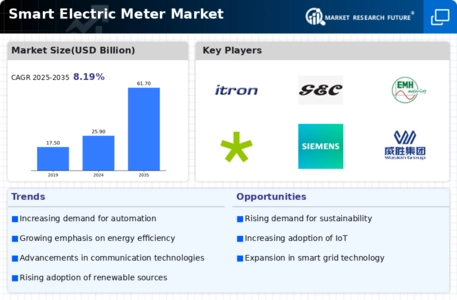Market Growth Projections
The Global Smart Electric Meter Market Industry is poised for substantial growth, with projections indicating a market value of 25.9 USD Billion in 2024 and an anticipated increase to 61.7 USD Billion by 2035. This growth trajectory suggests a compound annual growth rate (CAGR) of 8.23% from 2025 to 2035. Such figures reflect the increasing adoption of smart metering technologies across various regions, driven by factors such as technological advancements, regulatory support, and rising consumer demand for energy efficiency. The market's expansion underscores the critical role of smart electric meters in modernizing energy infrastructure and promoting sustainable energy practices.
Growing Demand for Energy Efficiency
The Global Smart Electric Meter Market Industry experiences a notable surge in demand for energy efficiency solutions. Governments and regulatory bodies worldwide are increasingly emphasizing the reduction of energy consumption and greenhouse gas emissions. Smart electric meters facilitate real-time monitoring of energy usage, enabling consumers to make informed decisions about their consumption patterns. This trend is underscored by the projected market value of 25.9 USD Billion in 2024, indicating a robust growth trajectory. As energy efficiency becomes a priority, the adoption of smart meters is likely to accelerate, contributing to the overall expansion of the Global Smart Electric Meter Market Industry.
Government Initiatives and Incentives
Government initiatives and incentives significantly influence the Global Smart Electric Meter Market Industry. Many countries are implementing policies to promote the deployment of smart meters as part of their energy transition strategies. These initiatives often include financial incentives, grants, and regulatory frameworks that encourage utilities to invest in smart metering infrastructure. For instance, various governments have set ambitious targets for smart meter installations, which are expected to enhance grid reliability and consumer engagement. Such supportive measures are likely to propel the market forward, aligning with the projected CAGR of 8.23% from 2025 to 2035.
Rising Consumer Awareness and Engagement
The Global Smart Electric Meter Market Industry is witnessing a rise in consumer awareness regarding energy consumption and sustainability. As consumers become more informed about their energy usage, they increasingly demand tools that provide transparency and control over their consumption patterns. Smart electric meters empower consumers by offering detailed insights into their energy usage, enabling them to make more sustainable choices. This growing engagement is expected to drive the adoption of smart meters, contributing to the market's anticipated growth. The increasing focus on consumer-centric solutions aligns with the broader trends in the energy sector, further enhancing the market landscape.
Integration with Renewable Energy Sources
The integration of renewable energy sources into the grid is a crucial driver for the Global Smart Electric Meter Market Industry. As countries strive to meet their renewable energy targets, smart electric meters facilitate the efficient management of distributed energy resources. These meters enable utilities to monitor and manage energy flows from various sources, including solar and wind, ensuring grid stability. The increasing penetration of renewables is likely to necessitate advanced metering solutions, thereby driving market growth. This trend aligns with the broader shift towards sustainable energy systems, further underscoring the importance of smart electric meters in the evolving energy landscape.
Technological Advancements in Metering Solutions
Technological innovations play a pivotal role in shaping the Global Smart Electric Meter Market Industry. The integration of advanced technologies such as IoT, AI, and machine learning into smart meters enhances their functionality and user experience. These advancements allow for improved data analytics, predictive maintenance, and enhanced customer engagement. As a result, utilities can optimize their operations and reduce costs. The anticipated growth of the market to 61.7 USD Billion by 2035 reflects the increasing reliance on sophisticated metering solutions. This trend suggests that technological progress will continue to drive the adoption of smart electric meters globally.




















Leave a Comment